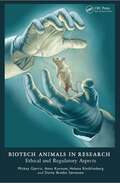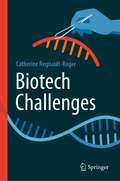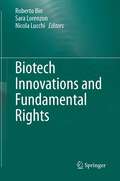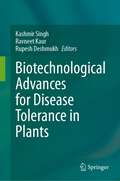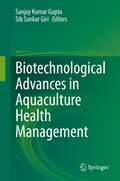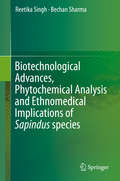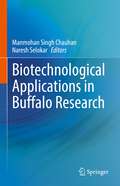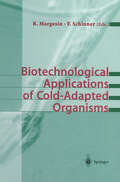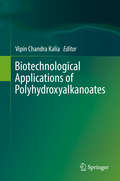- Table View
- List View
Biotech Animals in Research: Ethical and Regulatory Aspects
This book explores central aspects of genetic modification of animals for scientific purposes in the context technological possibilities, regulatory issues in different regions, animal welfare implications and wider ethical issues exemplified through current theories and frameworks. This discussion of lab animals produced through modern biotechnologies becomes increasingly pressing as CRISPR-Cas9 technology advances rapidly, challenging legal and ethical frameworks all over the world. Such animals are now affordable and readily available to almost every branch of scientific research. This not only raises enormous potential for creating ‘tailored’ models for human diseases but also rubs up against the traditional guiding principles (the 3Rs) for the humane use of animals for scientific experiments and raises wider ethical issues around death, integrity and naturalness. In this book, expert authors from diverse backgrounds in laboratory animal care, animal research, technology and animal rights explore a range of topics, from the science behind biotech research animals and the regulation of their use, to utilitarian, animal rights, virtue ethics and ethics of care, and critical animal studiers' perspectives on the use of these technologies. Whatever your background or role in animal research, this book will challenge and stimulate deeper consideration of the benefits, disadvantages and ethical consequences of the use of biotechnology in the animal laboratory.
The Biotech Business Handbook: How to Organize and Operate a Biotechnology Business, Including the Most Promising Applications for the 1990s
by Michael G. PappasOne comment often repeated to me by coworkers in the biotechnology industry deals with their frustration at not understanding how their particular roles fit into their company's overall scheme for developing, manufacturing, and marketing biomedical products. Although these workers know their fields of specialty and responsibilities very well, whether it be in product research and development, regulatory affairs, manufacturing, packaging, quality control, or marketing and sales, they for the most part lack an understanding of precisely how their own contributory pieces fit into the overall scheme of the corporate biotechnology puzzle. The Biotech Business Handbook was written to assist the biotechnologist-whether a tech nician, senior scientist, manager, marketing representative, or college student interested in entering the field-in building a practical knowledge base of the rapidly expanding and maturing biotechnology segment of the healthcare industry. Because biotechnology in the United States and abroad covers many disciplines, much of the information presented in this book deals with the biomedical diagnostic aspects of the industry. Business subjects for the most part unfamiliar to technically oriented people, such as the types of biotechnology corpo rations, their business and corporate structures, their financing, patent, and trademark mat ters, their special legal issues, and the contributions of their consultants are treated in a manner designed to make them clear and understandable.
Biotech Challenges
by Catherine Regnault-RogerThe evolution of genome’s modification by genetic engineering was characterized by a major technological breakthrough with the discovery of CRISPR in 2012. A distinction is now made between first-generation biotechnologies developed in the 20th century and current second-generation biotechnologies, NGT or New Genomic Techniques, including genome editing. How do we consider these genomic modifications compared to those that occur spontaneously in nature? What are the applications of these techniques in the fields of plants, animals, and human health? What prospects in terms of development and independence for countries and at least what regulations are in force on the different continents?The book questions what GMOs are, genome editing products and the place of genomic transformations today and tomorrow in our societies. It tries to give some geostrategic and regulatory benchmarks on biotech products in order to better understand the current issues.
Biotech Funding Trends: Insights from Entrepreneurs and Investors
by Alexandra Carina GruberBased on interviews with successful biotech entrepreneurs and high-level investors as well as case studies, this title provides a comprehensive overview of current trends in biotech funding. In particular, it illustrates the tensions between both sides based on their different backgrounds and expectations. The book outlines the various funding opportunities for the biotech industry and identifies ways for both sides to overcome their existing prejudices in order to successfully thrive in a competitive environment. A must-have for biotech entrepreneurs and investors, as well as invaluable supplementary reading for students aspiring to a career in the industry.
Biotech in China: Innovation, Politics, and Economics
by Rolf Schmid Xin XiongIn her quest for global leadership in science and technology, the People’s Republic of China has attained top ranks in the number of scientific publications, "hot papers," or national and international patent applications. However, analysis of the underlying structures and mechanisms is hindered by the sheer flood of data, stringent government control of all media, and ambiguities inherent in translation from Chinese. This book overcomes these difficulties and provides a concise picture of biotechnology-related research and development in China. It begins with brief accounts of China’s geography, people, political and administrational structure, economy, finance, infrastructure related to science and technology, and educational system. It presents succinct accounts on structures and developments in biomedicine, diagnostics, agriculture, fermented food, bioindustry, and environmental biotechnology, with reference to government, industry, and academia. Finally, it predicts the next steps in Chinese biotechnology for the national agenda and, in view of China’s ambitious global development strategy, the Belt and Road Initiative.
Biotech in China: Innovation, Politics, and Economics
by Rolf Schmid Xin XiongIn her quest for global leadership in science and technology, the People’s Republic of China has attained top ranks in the number of scientific publications, "hot papers," or national and international patent applications. However, analysis of the underlying structures and mechanisms is hindered by the sheer flood of data, stringent government control of all media, and ambiguities inherent in translation from Chinese. This book overcomes these difficulties and provides a concise picture of biotechnology-related research and development in China. It begins with brief accounts of China’s geography, people, political and administrational structure, economy, finance, infrastructure related to science and technology, and educational system. It presents succinct accounts on structures and developments in biomedicine, diagnostics, agriculture, fermented food, bioindustry, and environmental biotechnology, with reference to government, industry, and academia. Finally, it predicts the next steps in Chinese biotechnology for the national agenda and, in view of China’s ambitious global development strategy, the Belt and Road Initiative.
Biotech Industry: A Global, Economic, and Financing Overview
by Bryan Bergeron Paul Chan"The biotech industry is a complex, rapidly evolving, and critical industry. The industry holds great commercial and societal promise, but it is also filled with hype, confusion, and risks. Bergeron and Chan do a remarkable job of providing a sweeping insightful, and probing assessment of the current state and likely evolution of this global industry. This book is essential reading for the executive who desires a thorough understanding of this business and its potential."--John P. Glasser, Vice President and Chief Information Offers, Partners Healthcare System, Inc. "Bergeron and Chan have done a marvelous job integrating many different perspectives to give the reader a coherent road map of the biotech industry for the next decade. This powerful book is anchored by numerous relevant examples that create a framework which any life sciences professional needs to understand. Of particular note is the compelling assessment of the IT industry and its impact on the life sciences as these industries converge."--Michael A. Greeley, Managing General Partner, IDG Ventures. An in-depth examination of the growth and financing of the biotechnology industry worldwide Biotech Industry: A Global, Economic, and Financing Overview provides a thorough look at the current state of the biotechnology industry, including where major research is being conducted, where it's being applied, and where money and intellectual capital are flowing. Written by a renowned business columnist and an entrepreneurial scientist in the biotech area, this unique book gives Eos and other senior-level managers an understanding of Asia's pivotal role in the worldwide success of biotechnology commercialization, as well as insight into the biotech market over the next decade.
Biotech Innovations and Fundamental Rights
by Roberto Bin, Sara Lorenzon and Nicola LucchiBiotechnology is a recognized research area that has increasingly advanced into new technologies and modern practices raising several legal, ethical and regulatory issues. The revolutionary speed of biotech innovations has had a significant impact on the protection of the rights of the individual. Fundamental rights provide a framework within which the justification of limitations and restrictions to biotechnology innovations and research results have to be assessed. The legal regulation of scientific research and scientific investigations impact more and more directly on the freedom of research and therapies as well as on the broad diffusion of knowledge. Closely related is also the debated question of the technological manipulation of life and the boundary of scientific knowledge with regard to the topical question of genetic invention patents and their side effects on access to scientific information and health care opportunities.Drawing on expertise from different disciplines, the volume comprises invited papers and plenary presentations given at the conference entitled “Biotech Innovations & Fundamental Rights” that took place on Januray 20-21 2011 at the Department of Juridical Sciences of the University of Ferrara. Each contribution covers a different aspect of the legal and scientific issues involved in regulation of biotechnology. In particular the focus of attention has been given to genetic research, genetic data, freedom of scientific research in genetics and biotech patents.
Biotech Juggernaut: Hope, Hype, and Hidden Agendas of Entrepreneurial BioScience
by Tina Stevens Stuart NewmanBiotech Juggernaut: Hope, Hype, and Hidden Agendas of Entrepreneurial BioScience relates the intensifying effort of bioentrepreneurs to apply genetic engineering technologies to the human species and to extend the commercial reach of synthetic biology or "extreme genetic engineering." In 1980, legal developments concerning patenting laws transformed scientific researchers into bioentrepreneurs. Often motivated to create profit-driven biotech start-up companies or to serve on their advisory boards, university researchers now commonly operate under serious conflicts of interest. These conflicts stand in the way of giving full consideration to the social and ethical consequences of the technologies they seek to develop. Too often, bioentrepreneurs have worked to obscure how these technologies could alter human evolution and to hide the social costs of keeping on this path. Tracing the rise and cultural politics of biotechnology from a critical perspective, Biotech Juggernaut aims to correct the informational imbalance between producers of biotechnologies on the one hand, and the intended consumers of these technologies and general society, on the other. It explains how the converging vectors of economic, political, social, and cultural elements driving biotechnology’s swift advance constitutes a juggernaut. It concludes with a reflection on whether it is possible for an informed public to halt what appears to be a runaway force.
Biotech Juggernaut: Hope, Hype, and Hidden Agendas of Entrepreneurial BioScience
by Tina Stevens Stuart NewmanBiotech Juggernaut: Hope, Hype, and Hidden Agendas of Entrepreneurial BioScience relates the intensifying effort of bioentrepreneurs to apply genetic engineering technologies to the human species and to extend the commercial reach of synthetic biology or "extreme genetic engineering." In 1980, legal developments concerning patenting laws transformed scientific researchers into bioentrepreneurs. Often motivated to create profit-driven biotech start-up companies or to serve on their advisory boards, university researchers now commonly operate under serious conflicts of interest. These conflicts stand in the way of giving full consideration to the social and ethical consequences of the technologies they seek to develop. Too often, bioentrepreneurs have worked to obscure how these technologies could alter human evolution and to hide the social costs of keeping on this path. Tracing the rise and cultural politics of biotechnology from a critical perspective, Biotech Juggernaut aims to correct the informational imbalance between producers of biotechnologies on the one hand, and the intended consumers of these technologies and general society, on the other. It explains how the converging vectors of economic, political, social, and cultural elements driving biotechnology’s swift advance constitutes a juggernaut. It concludes with a reflection on whether it is possible for an informed public to halt what appears to be a runaway force.
Biotechnological Advances for Disease Tolerance in Plants
by Kashmir Singh Ravneet Kaur Rupesh DeshmukhThis book covers the biotechnological advances being used for the understanding of plant diseases and the subsequent enhancement of disease resistance in crop plants. Chapters are focused on recent advances in sequencing technologies, computational resources and genomics tools useful for the identification of loci governing disease resistance. In addition, emphasis is given to novel approaches like genomic selection for achieving significant genetic gain for quantitative disease resistance. The book thoroughly describes sequencing-based approaches like whole genome sequencing, resequencing, and transcriptome profiling being explored for the understanding of disease resistance mechanisms. Finally, several chapters systematically describing the utilities and concerns of high-end technologies like genome-editing are provided. Simplified Illustrations are provided in every chapter to explain different biotechnological approaches and strategies. The book will help to better explore the biotechnological advances in development of disease resistant crop varieties.
Biotechnological Advances for Microbiology, Molecular Biology, and Nanotechnology: An Interdisciplinary Approach to the Life Sciences
by Jyoti Ranjan Rout, PhD, Rout George Kerry and Abinash DuttaBiotechnological Advances for Microbiology, Molecular Biology, and Nanotechnology: An Interdisciplinary Approach to the Life Sciences presents cutting-edge research associated with the beneficial implications of biotechnology on human welfare. The volume mainly focuses on the highly demanding thrust areas of biotechnology that are microbiology, molecular biology, and nanotechnology. The book provides a detailed overview of the beneficial roles of microbes and nanotechnology-based engineered particles in biological developments. Also, it highlights the role of epigenetic machinery and redox modulators during the development of diseases. In addition, it provides research on nanotechnology-based applications in tissue engineering, stem cell, and regenerative medicines. Overall, the book provides an extended platform for acquiring the methodological knowledge needed for today’s biotechnological applications, such as DNA methylation, redox homeostasis, CRISPR, nano-based drug delivery systems, proteomics, genomics, metagenomics, bioluminescence, bioreactors, bioremediation, biosensors, etc. Divided into three sections, the book first highlights some recent trends in applied microbiology used in different areas, such as crop improvement, wastewater treatment, drug delivery, healthcare management, and more. The volume goes on to cover some advances in cellular and molecular mechanisms, such as CRISPR technology in biological systems, induced stem cells in disease prevention, integrated omics technology, and others. The volume also explores the indispensable role of nanotechnology in the precisely modulating intricate functioning of an organism in diagnostic and therapy along its application in tissue engineering and regenerative medicine and in food science as well as its role in ecological sustainability. This multidisciplinary volume will be highly valuable for the researchers, scientists, biologists, and faculty and students striving to expand their horizon of knowledge in their respective fields.
Biotechnological Advances for Microbiology, Molecular Biology, and Nanotechnology: An Interdisciplinary Approach to the Life Sciences
by Jyoti Ranjan Rout Rout George Kerry Abinash DuttaBiotechnological Advances for Microbiology, Molecular Biology, and Nanotechnology: An Interdisciplinary Approach to the Life Sciences presents cutting-edge research associated with the beneficial implications of biotechnology on human welfare. The volume mainly focuses on the highly demanding thrust areas of biotechnology that are microbiology, molecular biology, and nanotechnology. The book provides a detailed overview of the beneficial roles of microbes and nanotechnology-based engineered particles in biological developments. Also, it highlights the role of epigenetic machinery and redox modulators during the development of diseases. In addition, it provides research on nanotechnology-based applications in tissue engineering, stem cell, and regenerative medicines. Overall, the book provides an extended platform for acquiring the methodological knowledge needed for today’s biotechnological applications, such as DNA methylation, redox homeostasis, CRISPR, nano-based drug delivery systems, proteomics, genomics, metagenomics, bioluminescence, bioreactors, bioremediation, biosensors, etc. Divided into three sections, the book first highlights some recent trends in applied microbiology used in different areas, such as crop improvement, wastewater treatment, drug delivery, healthcare management, and more. The volume goes on to cover some advances in cellular and molecular mechanisms, such as CRISPR technology in biological systems, induced stem cells in disease prevention, integrated omics technology, and others. The volume also explores the indispensable role of nanotechnology in the precisely modulating intricate functioning of an organism in diagnostic and therapy along its application in tissue engineering and regenerative medicine and in food science as well as its role in ecological sustainability. This multidisciplinary volume will be highly valuable for the researchers, scientists, biologists, and faculty and students striving to expand their horizon of knowledge in their respective fields.
Biotechnological Advances in Aquaculture Health Management
by Sanjay Kumar Gupta Sib Sankar GiriThis book is an inclusive coverage of advances in aquaculture health management. It offers latest updates as well as explains the novel concepts and issues related to aquatic animal health management. To support the understanding of the concepts, there is extensive use of illustrations. Chapters emphasize on the state of art techniques and hold great promise for the sustainable development of aquaculture. This book is of interest to teachers, researchers, aquatic biologists, capacity builders and policymakers. Also the book serves as additional reading material for undergraduate and graduate students of aquatic sciences, marine sciences, biotechnology, ecology, and environmental sciences. National and international aquatic scientists, policy makers will also find this to be a useful read.
Biotechnological Advances in Bamboo: The “Green Gold” on the Earth
by Zishan Ahmad Yulong Ding Anwar Shahzad“Green gold” or “Poor Man’s Timber” are commonly used terms for bamboo that is a valuable and renewable resource of the world, and has always been an elemental part of human beings in terms of social and economic value. Bamboo is considered a multipurpose plant and has a prolonged history as an adaptable and extensively used renewable resource in conventional and commercial applications. Therefore, the annual demands for bamboos have already out-crossed the annual yields across the world. And the current scenario has forced scientists to pay more attention to the utilization of biotechnological tools for better understanding and improving bamboos. The book provides an overview of the different biotechnological approaches to advance bamboo research and better utilization of bamboo resources for human beings. Various applications of biological techniques in relation to bamboo have been discussed in details, for example, plant tissue culture techniques, somatic embryogenesis, germplasm conservation techniques, use of the molecular markers, transcriptomics, polymorphism, and phylogenetic relations in bamboo. It also addresses the novel industrial applications of bamboo in structural, food, and pharmaceuticals along with traditional uses. The aggregated information in this book demonstrates the way for the improved and sustainable practice of bamboos to fulfill the future needs of the world. This book is intended for use in both the industry and academia
Biotechnological Advances, Phytochemical Analysis and Ethnomedical Implications of Sapindus species
by Reetika Singh Bechan SharmaPlants have always occupied a prominent position in the life of every living being. Plants are the primary source of food, shelter and medicines. The global inclination toward herbal medicine has advanced the expansion of plant-based pharmaceutical industries to a vast extent. The production of traditional medicine at global market has been estimated to touch US $5 trillion by 2050. Some of the useful plant-based drugs include vinblastine, vincristine, taxol, podophyllotoxin, camptothecin, digoxigenin, morphine, codeine, aspirin, atropine, capscicine, allicin, curcumin, artemesinin and ephedrine. Genus Sapindus is an important economical and medicinal trees, distributed over the world. Soap nuts contain higher amount of saponin, a natural detergent which can be used to clean clothes and hairs. Sapindus species possesses various pharmacological properties including antimicrobial, antioxidant, anti-inflammatory, anticancer, hepatoprotective, anti-trichomonas activity. Extracts of this plant are rich in various phytochemicals and polyphenolic compounds. All the pharmacological properties are due to presence of saponins. Biotechnological techniques can improve the saponin content; thus this chemical content can be produced at large scale and can be used as phytomedicine. We hope that this book would be of great use to under graduates, postgraduates, scientists, researchers and faculty members who are studying, teaching or working in the field of Biotechnology, Phytochemistry and Ethnopharmacology. The techniques explained in this book could be of immense use for the researchers working in this area. We shall deeply appreciate receiving any critical comments and suggestions from the readers from the different parts of globe which would help us improve the first edition of this publication.
Biotechnological Applications in Buffalo Research
by Manmohan Singh Chauhan Naresh SelokarThis book comprehensively reviews the advancements in biotechnological applications for the enhanced production and conservations of buffalo (Bubalus bubalis). The book discusses developments in assisted reproduction to improve productivity and the produce novel products for applications to human health and nutrition. The initial chapters of the book discuss the global distribution and domestications of buffalo, and nutritive values of buffalo milk, while the subsequent sections examine the applications of the genome-wide association traits to identify potential genetic variants affecting important economic traits. It identifies predictive biomarkers for postpartum or peripartum diseased-state and presents potential protein biomarkers for the diagnosis of early pregnancy in buffalo. Lastly, it discusses recent scientific developments such as induced pluripotent stem cells, spermatogonial stem cells, somatic cell nuclear transfer, and buffalo as a model for human biomedical research. This book is a useful source to students, academicians, researchers, and policymakers who are involved in buffalo science and industry.
Biotechnological Applications in Human Health
by Provash Chandra Sadhukhan Sanjay PremiThis book compiles selected articles presented at the International Conference on Biotechnology & Biological Sciences, BIOSPECTRUM 2017, organized by the Department of Biotechnology, University of Engineering & Management, Kolkata. Focusing on biotechnology-based analysis and intervention to address certain human diseases, the book includes a holistic discourse on disease profiling, molecular level analysis of diseases, and non-invasive medical interventions. It features articles on non-invasive treatment of iron deficiency anemia with iron nanoparticles; novel diagnosis methods based on microarray data; analysis using machine learning techniques like artificial neural network for early detection and treatment of cancer; and drug discovery for preventing the growth of human leukemic cells. Further, the book sheds light on in silico drug design using lipopeptides, and identifying the binding sites for their corresponding ligands. Presenting the concepts of the design of potent and safe antimicrobial compounds to fight multi drug resistant pathogens, it also includes interesting reviews on the design and development of various non-invasive methods, such as multi NIR wavelength probes to identify the risk areas in the diabetic foot at an early stage; and a low-cost cochlear implant prototype designed and developed from commercial off the-shelf components to empower the hearing impaired.The book appeals to students, academics and researchers in a wide range of subject areas, including biotechnology, life sciences, medicine and cancer research.
Biotechnological Applications of Biodiversity (Advances in Biochemical Engineering/Biotechnology #147)
by Joydeep MukherjeeThis book review series presents current trends in modern biotechnology. The aim is to cover all aspects of this interdisciplinary technology where knowledge, methods and expertise are required from chemistry, biochemistry, microbiology, genetics, chemical engineering and computer science. Volumes are organized topically and provide a comprehensive discussion of developments in the respective field over the past 3-5 years. The series also discusses new discoveries and applications. Special volumes are dedicated to selected topics which focus on new biotechnological products and new processes for their synthesis and purification. In general, special volumes are edited by well-known guest editors. The series editor and publisher will however always be pleased to receive suggestions and supplementary information. Manuscripts are accepted in English.
Biotechnological Applications of Cold-Adapted Organisms
by Rosa Margesin Franz SchinnerHow can industry profit from the biochemical tricks of cold-adapted organisms? This book covers a range of aspects in this fascinating field, from genetic tools to environmental biotechnology.
Biotechnological Applications of Lipid Microstructures (Advances in Experimental Medicine and Biology #238)
by B. P. GaberIn the twenty years since Bangham first described the model membrane system which he named "liposomes", a generation of scientists have explored the properties of lipid-based microstructures. Liposomes of all sizes, tubular and helical structures, and self-assembled lipid films have been prepared and studied in detail. Many of the advances· in the basic research have led to significant technological applications. Lipid microstructure research has begun to mature and it is an appropriate time for an in-depth look at the biotechnological applications, both achieved and potential. As a forum for active discussions within this growipg field, two Workshops were organized: "Technological Applications of Phospholipid Bilayers, Vesicles and Thin Films", held in Puerto de la Cruz, Tenerife, Canary Islands; and "Biotechnological Applications of Membrane Studies", held in Donostia-San Sabastian, Basque Country, Spain. The organizers of these Workshops believe that development of lipid self-assembly into a technological discipline requires significant interaction across traditional scientific boundaries. Thus the Workshops gathered an eclectic group of colleagues whose interests ranged from basic research into structure, interactions and stabilization of biomembranes to applications of lipid microstructures such as artificial cells, diagnostic reagents, energy transfer systems, and biosensors.
Biotechnological Applications of Photosynthetic Proteins: Biochips, Biosensors and Biodevices (Biotechnology Intelligence Unit)
by Maria Teresa Giardi Elena PiletskaBiotechnological Applications of Photosynthetic Proteins: Biochips, Biosensors and Biodevices provides an overview of the recent photosystem II research and the systems available for the bioassay of pollutants using biosensors that are based on the photochemical activity. The data presented in this book serves as a basis for the development of a commercial biosensor for use in rapid pre-screening analyses of photosystem II pollutants, minimising costly and time-consuming laboratory analyses.
Biotechnological Applications of Plant Proteolytic Enzymes
by María Gabriela Guevara Gustavo Raúl DaleoThis book offers an overview of the diverse fields application of proteases (also termed proteolytic enzymes or proteinases), including food science and technology, pharmaceutical industries, and detergent manufacturing, reviewing the advances in the biotechnological application plant proteolytic enzymes over the last decade. In recent years, they have been the focus of renewed attention from the pharmaceutical and biotechnology industries, not only because of their activity on a wide variety of proteins but also because they are active over a range of temperatures and pHs. The main audience of this book are researchers working with plant proteases but also professionals from several industry segments such as food production and pharmaceutical companies.
Biotechnological Applications of Polyhydroxyalkanoates
by Vipin Chandra KaliaThis book presents the latest research on the uses of polyhydroxyalkanoates (PHA), introducing readers to these natural, biodegradable polyesters produced by microorganisms, their functions and applications. The individual chapters discuss the various potentials of these bioplastics, which offer an attractive alternative to non-biodegradable plastics. The book also describes the diverse medical and biomedical applications of PHAs, including their use as drug carriers, memory enhancers, and biocontrol agents, and examines their role in creating a more sustainable economy – which is the need of the hour.
Biotechnological Applications of Quorum Sensing Inhibitors
by Vipin Chandra KaliaThis book discusses the practical applications of quorum sensing inhibitors for both human and plant health. Quorum sensing inhibitors that disrupt microbial biofilms can be employed to treat bacterial infections. The book describes the various bioactive molecules that can serve as quorum sensing inhibitors to combat deadly bacterial infections, in addition to several synthetic quorum sensing inhibitors. Quorum sensing is the mechanism through which bacteria develop antibiotic resistance. Intended to provide a clearer understanding of the practical applications of quorum sensing inhibitors, the book details how the problem of antibiotic resistance can be countered through the intelligent application of quorum sensing inhibitors.
